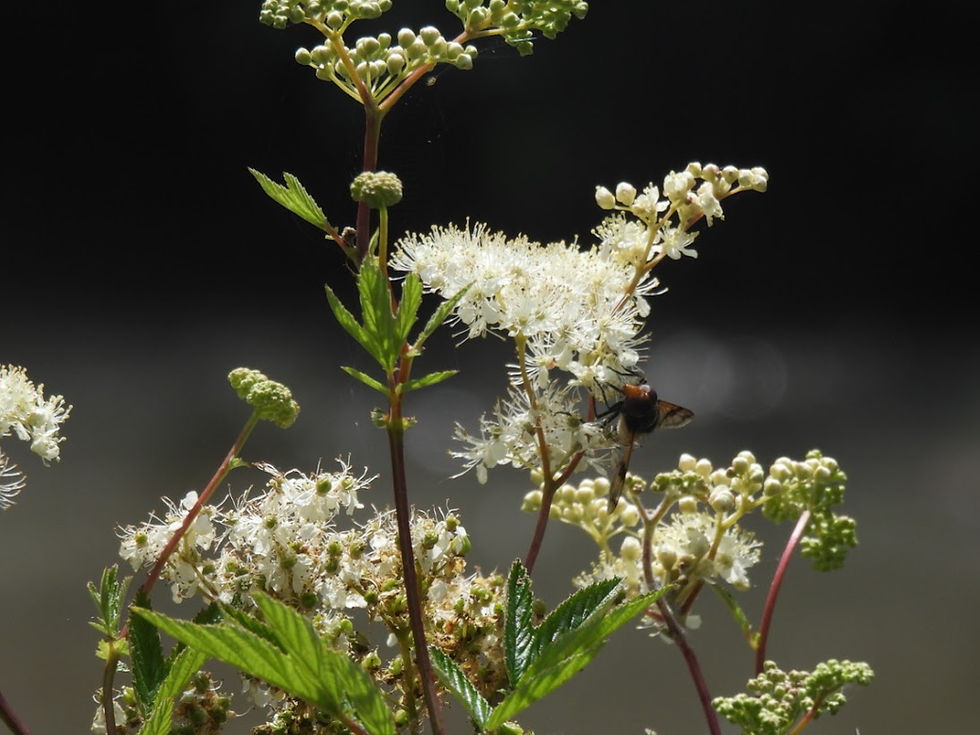Botanical finds at Leonardslee Gardens. A Sussex Botanical Recording Society field meeting. 26.07.23
- Sim Elliott

- Jul 28, 2023
- 4 min read
This trip to Leonardslee Gardens was a wonderful experience, as I learnt a great deal, and saw many new-to-me species. As a novice amateur botanist, I would really recommend Botanical Society of Britain & Ireland local group meetings; it is the best way to learn!
Getting to Leonardslee from Brighton by public training is very straightforward. The Stagecoach 17 bus runs from Brighton, and stops outside the gardens, every hour, and the journey time is about 80 minutes. 17 - Brighton - Horsham – Stagecoach South – bustimes.org
All sections of text in italics are quotations, sources sited.
The photographs in this post are in chronological order (order of being seen)
I am only an amateur naturalist; but nearly all these identification were made by others, i.e. more experienced botanists than me! If you note a mistake in identification please feel free to tell me. If you want to contact me about any aspect of this blog, email me at simeon[underscore]elliott[at]gmail[dot]com.
Aside from being a formal garden, with many non-native exotic plants, there are areas of ancient woodland and wet acid heathland at Leonardslee; remnants of its former history, being part of the larger medieval St Leonards Forest that stretched across the High Weald; it was one of the Royal (hunting) Forests of the High Weald (Hastings Beds Ridge). (See Francis Rose, The Habitats and Vegetation of Sussex, 1995, Brighton Borough Council pp. 21-22). Leonardslee is a fabulous place, although much has gone from the heathland boglands, including sundews and clubmosses, that were once there (according to Francis Rose); but there is still some very rare things, including Bog Myrtle and Wood Horsetail which have almost entirely disappeared from their previous locations in Sussex; and are only really found now with some abundance in the western Atlantic woodland (temperate rainforest) zone of the UK. The ancient High Weald woodland must have been magical before much of the woodland was cut down and built over. The woodlands of the High Weald have an oceanic microclimate which results in seeing some flowering plants, bryophytes and lichens more usually seen in the UK's Atlantic woodlands (Cornwall, Wales and the west coast of Scotland); see: Burnside, Niall & Metcalfe, Daniel & Smith, Roger & Waite, Steve. (2006). Ghyll Woodlands of the Weald: Characterisation and Conservation. Biodiversity and Conservation. 15. 1319-1338. 10.1007/s10531-005-3875-5. (PDF) Ghyll Woodlands of the Weald: Characterisation and Conservation (researchgate.net)
The formal woodland garden was inspired by the planting ideas of Sir Uvedale Price, Richard Payne Knight and JC Loudon. Exotic plants are used a 'picturesque' manner, derived from landscape painting. Sir Edmund Loder bought the estate in 1889 and imported the herd of Wallabies which still lives here. The Leonardslee Gardens lie in a sheltered valley with a string of ponds, made a century earlier to provide waterpower for the iron industry. Being damp and slightly acid, the soil is well-suited to rhododendrons, camelias and magnolias. Loder gave his name to the famous hybrid Rhododendron 'Loderi'. Leonardslee Gardens (gardenvisit.com)
We were assisted by an expert Leonardslee garner/botanist, who pointed out where some rare things were; we may not have seen some of these species without him, as some were small and tucked away amongst other plants.
This is what I particularly noted (in approximate chronological order). We saw many more things; please see the write up of the trip on Field Meetings - Sussex Botanical Recording Society (sussexflora.org.uk) when it is published for a full list of what we saw. Nearly all of these things I may not have seen if they were not pointed out by others!
Map from Visitor Information | Leonardslee Gardens (clock on msp to make map bigger

Woodland and path borders in/around the formal gardens (we walked from points G to A on map, then to Q):
Violet Helleborine - Epipactis purpurata
Scaly Male-fern - Dryopteris affinis
New Zealand Bittercress - Cardamine corymbosa (escapee from gardens and nurseries, now natirualised
Yellow Pimpernel - Lysimachia nemorum
Square-stalked St Johns-wort - Hypericum tetrapterum
Ivy-leaved Bellflower - Wahlenbergia hederacea
Wood Horsetail - Equisetum sylvaticum
Common Cow-wheat - Melampyrum pratense
Knotted Hedge-parsley - Torilis nodosa
Meadow Sweet - Filipendula ulmaria, Pied Plumhorn, Volucella pellucens,
Musk-mallow - Malva moschata
Water Figwort - Scrophularia auriculata with Median Wasp Dolichovespula media and
Deer Park (acid heath with bog) (S on the map)
Greater Bird's-foot-trefoil - Lotus pedunculatus
Large Thyme - Thymus pulegiodes
Rigid Eyebright - Euphrasia stricta
Sharp-flowered Rush - Juncus acutiflorus
Star Sedge - Carex echinata
Petty Whin - Genista anglica
Marsh St John's-wort - Hypericum eloides
Bog Pipernel - Anagalis tenella
Bog Mertle - Myrica gale
Skullcap - Scutellaria galericulata
Lesser Skullcap - Scutellaria minor
Violet Helleborine - Epipactis purpurata

New Zealand Bittercress - Cardamine corymbosa (escapee from gardens and nurseries, now natirualised


Scaly Male-fern - Dryopteris affinis


Yellow Pimpernel - Lysimachia nemorum

Square-stalked St Johns-wort - Hypericum tetrapterum

Ivy-leaved Bellflower - Wahlenbergia hederacea

Wood Horsetail - Equisetum sylvaticum

Common Cow-wheat - Melampyrum pratense


Knotted Hedge-parsley - Torilis nodosa

Pied Plumhorn, Volucella pellucens, on Meadow Sweet Filipendula ulmaria


Musk-mallow - Malva moschata

Water Figwort - Scrophularia auriculata, with, possibly, Hornet, Vespa crabro

Water Figwort - Scrophularia auriculata with Median Wasp, Dolichovespula

Greater Bird's-foot-trefoil - Lotus pedunculatus

Large Thyme - Thymus pulegiodes

Sharp-flowered Rush - Juncus acutiflorus

Rigid Eyebright - Euphrasia stricta

Flea Sedge - Carex pulicaris


Star Sedge - Carex echinata

Petty Whin - Genista anglica


Ivy-leaved Bellflower - Wahlenbergia hederacea

Marsh St John's-wort - Hypericum eloides


Bog Pipernel - Anagalis tenella

Bog Mertle - Myrica gale

Skullcap - Scutellaria galericulata

Lesser Skullcap - Scutellaria minor




Comments